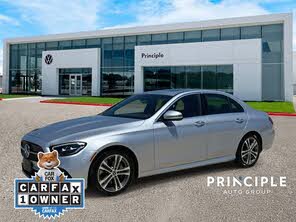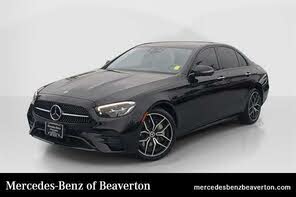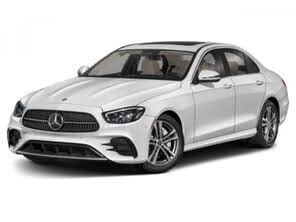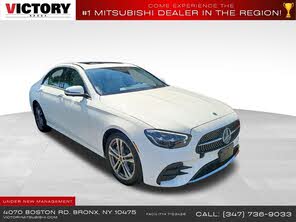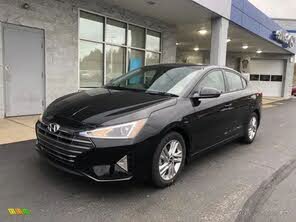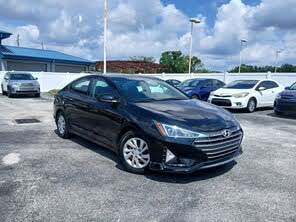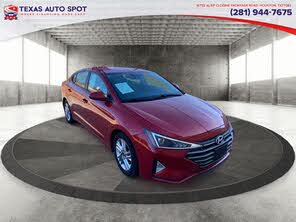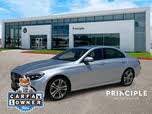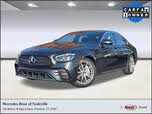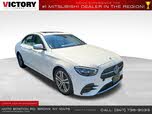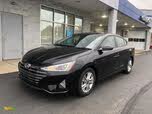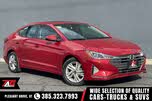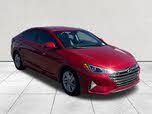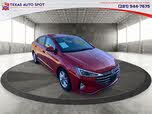2021 Mercedes-Benz E-Class vs 2020 Hyundai Elantra
Overview | |
MSRP$19,300 | MSRP$54,250 |
Listings1052 | Listings285 |
Ratings & Reviews | |
User Reviews | User Reviews |
Expert reviews8.3 out of 10 | Expert reviews8.3 out of 10 |
Pros
Cons
| Pros
Cons
|
2020 Hyundai Elantra Reviews SummaryHyundai isn’t pulling any punches when it comes to the compact car segment, where value is of utmost importance. And though a completely redesigned 2021 Elantra is coming soon, the automaker bestows several value-enhancing improvements upon the outgoing 2020 Hyundai Elantra compact sedan. They include free scheduled maintenance, improved fuel economy ratings, and new standard safety features. | |
2021 Mercedes-Benz E-Class Reviews SummaryWhen money is but a mild concern, a brand-new Mercedes-Benz is a reasonable purchase. The E-Class is the company's most practical and versatile car, as high-quality and necessary in a nice garage as a Kitchen-Aid mixer is in a baker's kitchen. It offers four body styles, four engines, and dozens of color schemes. Fast or efficient? Loud or library quiet? Modest or rich as hell? The E-Class is all of those things, depending on which of the 13 models you order and how deep into the options list you dive. For 2021, the E-Class receives a mid-cycle update for the infotainment system, engines, and exterior styling. We tested the AMG E53 that features a mild-hybrid inline-six powertrain. | |
No video found | |
Popular Features & Specs | |
Engine2.0L 147 hp I4 | Engine2.0L 255 hp I4 |
Drive TrainFWD | Drive TrainRWD |
Seating Capacity5 | Seating Capacity5 |
Horsepower147 hp @ 6200 rpm | Horsepower255 hp @ 5800 rpm |
MPG City31 | MPG City22 |
MPG Highway41 | MPG Highway31 |
Engine | |
Engine Name2.0L 147 hp I4 | Engine Name2.0L 255 hp I4 |
Torque132 lb-ft @ 4500 rpm | Torque273 lb-ft @ 1800 rpm |
Horsepower147 hp @ 6200 rpm | Horsepower255 hp @ 5800 rpm |
DrivetrainFWD | DrivetrainRWD |
Fuel Economy | |
MPG City31 | MPG City22 |
MPG Highway41 | MPG Highway31 |
Interior | |
Seating Capacity5 | Seating Capacity5 |
Key Features | |
Navigation System | Navigation SystemStandard |
Sunroof/Moonroof | Sunroof/MoonroofStandard |
Safety | |
Front Crash Overall4 | Front Crash Overall5 |
Side Crash Overall4 | Side Crash Overall5 |
Dimensions & Capacity | |
Cargo Space14.4 cu ft | Cargo Space13.1 cu ft |
Curb Weight2844 lbs | Curb Weight3781 lbs |
Height56.5 in | Height57.8 in |
Length181.9 in | Length194.3 in |
Width70.9 in | Width81.3 in |
Wheelbase106.3 in | Wheelbase115.7 in |
Maximum Payload1080 lbs | Maximum Payload |
Number of doors4 | Number of doors4 |
Overview | ||
MSRP | $19,300 | $54,250 |
Listings | ||
Ratings & Reviews | ||
User reviews | ||
Expert reviews | 8.3 out of 10Read full review | 8.3 out of 10Read full review |
Pros & cons | Pros
Cons
| Pros
Cons
|
Summary | Hyundai isn’t pulling any punches when it comes to the compact car segment, where value is of utmost importance. And though a completely redesigned 2021 Elantra is coming soon, the automaker bestows several value-enhancing improvements upon the outgoing 2020 Hyundai Elantra compact sedan. They include free scheduled maintenance, improved fuel economy ratings, and new standard safety features. | When money is but a mild concern, a brand-new Mercedes-Benz is a reasonable purchase. The E-Class is the company's most practical and versatile car, as high-quality and necessary in a nice garage as a Kitchen-Aid mixer is in a baker's kitchen. It offers four body styles, four engines, and dozens of color schemes. Fast or efficient? Loud or library quiet? Modest or rich as hell? The E-Class is all of those things, depending on which of the 13 models you order and how deep into the options list you dive. For 2021, the E-Class receives a mid-cycle update for the infotainment system, engines, and exterior styling. We tested the AMG E53 that features a mild-hybrid inline-six powertrain. |
Video | No video found | |
Popular Features & Specs | ||
Engine | 2.0L 147 hp I4 | 2.0L 255 hp I4 |
Drive Train | FWD | RWD |
Seating Capacity | 5 | 5 |
Horsepower | 147 hp @ 6200 rpm | 255 hp @ 5800 rpm |
MPG City | 31 | 22 |
MPG Highway | 41 | 31 |
Engine | ||
Engine Name | 2.0L 147 hp I4 | 2.0L 255 hp I4 |
Torque | 132 lb-ft @ 4500 rpm | 273 lb-ft @ 1800 rpm |
Horsepower | 147 hp @ 6200 rpm | 255 hp @ 5800 rpm |
Drivetrain | FWD | RWD |
Fuel Economy | ||
MPG City | 31 | 22 |
MPG Highway | 41 | 31 |
Interior | ||
Seating Capacity | 5 | 5 |
Key Features | ||
Navigation System | Standard | |
Sunroof/Moonroof | Standard | |
Safety | ||
Front Crash Overall | 4 | 5 |
Side Crash Overall | 4 | 5 |
Dimensions & Capacity | ||
Cargo Space | 14.4 cu ft | 13.1 cu ft |
Curb Weight | 2844 lbs | 3781 lbs |
Height | 56.5 in | 57.8 in |
Length | 181.9 in | 194.3 in |
Width | 70.9 in | 81.3 in |
Wheelbase | 106.3 in | 115.7 in |
Maximum Payload | 1080 lbs | |
Number of doors | 4 | 4 |
The 2020 Hyundai Elantra, last redesigned in 2017 and restyled in 2019, remained visually unchanged for the 2020 model year. The previous year's restyle introduced a geometric-influenced appearance, setting the stage for the dramatically angular styling of the 2021 Elantra. Available in six versions—SE, SEL, Value Edition, Eco, Limited, and Sport—the Elantra's price ranged from $19,300 to $24,150. The Limited test vehicle, with the Ultimate Package and floor mats, totaled $27,630, including the $975 destination charge. The Elantra GT hatchback was also available for 2020.
A black paint job highlighted the Elantra’s angular headlight, fog light, and wheel designs, contrasting with the chrome grille, beltline, and logo detailing. The result was a stylish small car, though not universally appealing. The interior received an upscale update with silver trim on various elements, but enough hard and glossy plastic remained to remind occupants that it was a mainstream compact car.
The 2021 Mercedes-Benz E-Class, part of the W213 generation introduced in 2017, featured a design shift from the sharper angles of the W212 to the fluid, curvier forms of the S-Class and C-Class. For 2021, the E-Class received edgier front styling with squinted headlights and an inverted trapezoid grille, while the rear resembled the W212 with horizontal taillights cutting into the trunk lid. New bumpers, exhaust tips, and wheels were the major changes, maintaining the car's handsome and elegant appearance across sedan, wagon, coupe, and convertible models.
The standing hood ornament on sedans and wagons was discontinued, a classic Mercedes look that fit the E-Class perfectly. The Sport package, popular among buyers, replaced the hood ornament with a large star in the grille. The AMG models, with vertical grille slats and a big star emblem, looked appropriate for their performance capabilities. The E-Class remained a reserved and conservative car from the outside, with the AMG models adding a touch of drama.











The 2020 Hyundai Elantra featured a base 147-horsepower, 2.0-liter four-cylinder engine paired with a new continuously variable transmission (CVT), replacing the previous six-speed automatic. The CVT, standard with SE trim, contributed to a $1,100 price increase from the previous year. All Elantra models were front-wheel drive. The Elantra Eco had a turbocharged 1.4-liter four-cylinder engine producing 128 horsepower and 156 lb-ft of torque, paired with a seven-speed dual-clutch automatic transmission (DCT) and an automatic engine start/stop system, achieving 36 mpg in combined driving.
The Elantra Sport trim featured a 1.6-liter turbo four-cylinder engine with 201 horsepower and 195 lb-ft of torque, and an independent rear suspension for improved ride quality. The Sport trim lost its manual gearbox for 2020, standardizing the seven-speed DCT. The Elantra Limited test car, with its 2.0-liter engine and new CVT, provided a satisfactory driving experience, with the CVT offering simulated gear shifts for a traditional automatic feel. However, real-world fuel economy fell short of expectations, averaging 29.3 mpg compared to the EPA-rated 34 mpg.
The 2021 Mercedes-Benz E-Class saw a significant change with the switch from conventional V6 engines to electrified inline-six powertrains for the E450 model, now a hybrid. The 3.0-liter I6 engine, with a single turbo and a 48-volt electrical system, produced 362 horsepower and 369 lb-ft of torque, with an additional 21 horsepower and 184 lb-ft from the electric starter-generator. The base E350's 2.0-liter turbo four-cylinder engine, revised for 2020, was adequate for everyday driving but lacked the performance expected of a luxury car.
The AMG E53 model added a second turbo, powered by the 48-volt battery, producing 429 horsepower and 384 lb-ft of torque. The AMG E63 S, with a hand-built 4.0-liter V8 engine, delivered 603 horsepower and 627 lb-ft of torque, featuring advanced performance technologies like variable-rate air suspension and rear-biased all-wheel drive. Fuel economy for the AMG models was lower, with the E53 sedan rated at 25 mpg combined and the E63 sedan at 18 mpg combined. The E450 4Matic and E350 4Matic sedans achieved 26 mpg and 25 mpg combined, respectively.
The 2020 Hyundai Elantra offered roomy accommodations for four adults, with a fifth person fitting for short trips. The Limited test car featured power driver’s seat adjustment, leather upholstery, and a sliding center console armrest. All Elantras included a front passenger's seat-height adjuster and a dual-zone automatic climate control system with a Clean Air ionizer and automatic defogging. Heated front seats were standard on all but the SE and SEL trims, though rear air conditioning vents were not available.
Interior storage was well-proportioned for a compact car, and the trunk provided 14.4 cubic feet of space, comparable to some midsize sedans. A thoughtful touch was the interior grab handle inside the trunk lid, making it easy to close.
The 2021 Mercedes-Benz E-Class featured a redesigned infotainment system with a touchscreen interface, making everyday tasks easier. The touchpads on the steering wheel were reshaped, somewhat inhibiting menu navigation. Shortcut buttons for navigation, stereo, and other settings remained, though the analog clock was missed. Separate climate controls, drive mode switches, a touchpad, and seat controls on the doors enhanced user-friendliness, though mastering the dual screens required practice.
The E-Class cabin was spacious for four adults, with ample headroom and legroom, supportive cushions, and knee cutouts on the seatbacks. However, the E53 lacked rear USB ports, a separate climate zone, soft-close doors, or heated rear seats, despite a $101,000 MSRP. The coupe's rear seats were usable, while the convertible's were less so due to the folding soft top. The wagon offered a stowable rear-facing jump seat and more cargo space, with the sedan providing 13 cubic feet of trunk space and the two-door models offering 10 cubic feet or less with the roof down.
The 2020 Hyundai Elantra came standard with a touchscreen infotainment system, Bluetooth, and a USB port. The base SE trim featured a 5-inch screen, while the SEL trim upgraded to a 7-inch display with Apple CarPlay, Android Auto, and SiriusXM satellite radio. The Value Edition included a complimentary subscription to Blue Link Connected Car and Remote plans for three years. The Limited trim added wireless smartphone charging and a premium Infinity sound system, with the Ultimate Package increasing the touchscreen size to 8 inches and adding navigation and SiriusXM data services.
The infotainment system was user-friendly, with a high-mounted touchscreen display, shortcut buttons, and volume and tuning knobs. The voice recognition system was agreeable, and the Infinity sound system impressed with its depth of sound.
The 2021 Mercedes-Benz E-Class featured the MBUX infotainment system, with a touchscreen interface, better-organized menus, and natural voice processing. The system included gesture control, live feed overlays for navigation, and optional extras like perfume canisters and massaging seats. The instrument cluster offered customizable displays, from traditional analog gauges to bar graphs and zany colors.
Standard features included Apple CarPlay, Android Auto, 4G WiFi, and connected services. Optional driving assists could move the car into adjacent lanes, slow down for curves, and drive itself for limited times. The system was slick and fast, providing a high-tech experience.
The 2020 Hyundai Elantra featured Hyundai Smart Sense, a collection of advanced driving assistance systems (ADAS) including forward-collision warning, automatic emergency braking, lane departure warning, lane-keeping assist, and a driver attention monitor. Starting with SEL trim, the Elantra included blind-spot warning and rear cross-traffic alert. The Limited and Sport trims added full LED headlights with automatic high-beam operation. The Ultimate Package for the Limited trim included adaptive cruise control, a pedestrian detection system, and Safe Exit Assist.
The Elantra earned a Top Safety Pick from the Insurance Institute for Highway Safety (IIHS) when equipped with full LED headlights. The National Highway Traffic Safety Administration (NHTSA) gave the car an overall rating of four stars, noting a concern about rear-door intrusion during the side-impact test.
The 2021 Mercedes-Benz E-Class received a five-star overall rating from the NHTSA, with five stars in frontal and side crash tests and for rollover vulnerability. The driver's side received a four-star rating in the frontal crash test. The 2020 E-Class sedan was rated a "Top Safety Pick+" by the IIHS. The coupe and cabriolet models were not tested but were considered equally safe.
Mercedes innovations included Pre-Safe Sound, side bolsters that shift occupants during a side collision, and steering and brakes that counter crosswinds. Standard safety features included forward automatic emergency braking, a driver-attention monitor, and blind-spot monitoring. Optional features included 14 additional driver-assist systems.
CarGurus highlights

According to CarGurus experts, the overall rating for the 2020 Hyundai Elantra is 8.3 out of 10, while the 2021 Mercedes-Benz E-Class scores 8.3 out of 10. Both cars offer excellent features and performance, but the final recommendation depends on your priorities. If you seek luxury, advanced technology, and top-tier safety, the 2021 Mercedes-Benz E-Class is the better choice. However, if you prefer a budget-friendly, fuel-efficient compact car with a user-friendly infotainment system, the 2020 Hyundai Elantra is a solid option.
Choose the 2021 Mercedes-Benz E-Class if:
- You seek a luxurious and technologically advanced vehicle with a high-quality interior.
- You value a smooth and powerful performance with hybrid options.
- You want a car with top-tier safety features and innovative driver-assist systems.
Choose the 2020 Hyundai Elantra if:
- You want a budget-friendly compact car with a stylish design.
- You prioritize fuel efficiency and a user-friendly infotainment system.
- You need a car with advanced safety features and a spacious trunk.
CarGurus highlights

According to CarGurus experts, the overall rating for the 2020 Hyundai Elantra is 8.3 out of 10, while the 2021 Mercedes-Benz E-Class scores 8.3 out of 10. Both cars offer excellent features and performance, but the final recommendation depends on your priorities. If you seek luxury, advanced technology, and top-tier safety, the 2021 Mercedes-Benz E-Class is the better choice. However, if you prefer a budget-friendly, fuel-efficient compact car with a user-friendly infotainment system, the 2020 Hyundai Elantra is a solid option.
Choose the 2021 Mercedes-Benz E-Class if:
Shop Now- You seek a luxurious and technologically advanced vehicle with a high-quality interior.
- You value a smooth and powerful performance with hybrid options.
- You want a car with top-tier safety features and innovative driver-assist systems.
Choose the 2020 Hyundai Elantra if:
Shop Now- You want a budget-friendly compact car with a stylish design.
- You prioritize fuel efficiency and a user-friendly infotainment system.
- You need a car with advanced safety features and a spacious trunk.

By: CarGurus + AI
At CarGurus, our team of experienced automotive writers remain at the heart of our content operation, conducting hands-on car tests and writing insightful guides that are backed by years of industry experience. To complement this, we are harnessing AI to make our content offering more diverse and more helpful to shoppers than ever. To achieve this, our AI systems are based exclusively on CarGurus content, ratings and data, so that what we produce is both unique to CarGurus, and uniquely helpful to car shoppers.

